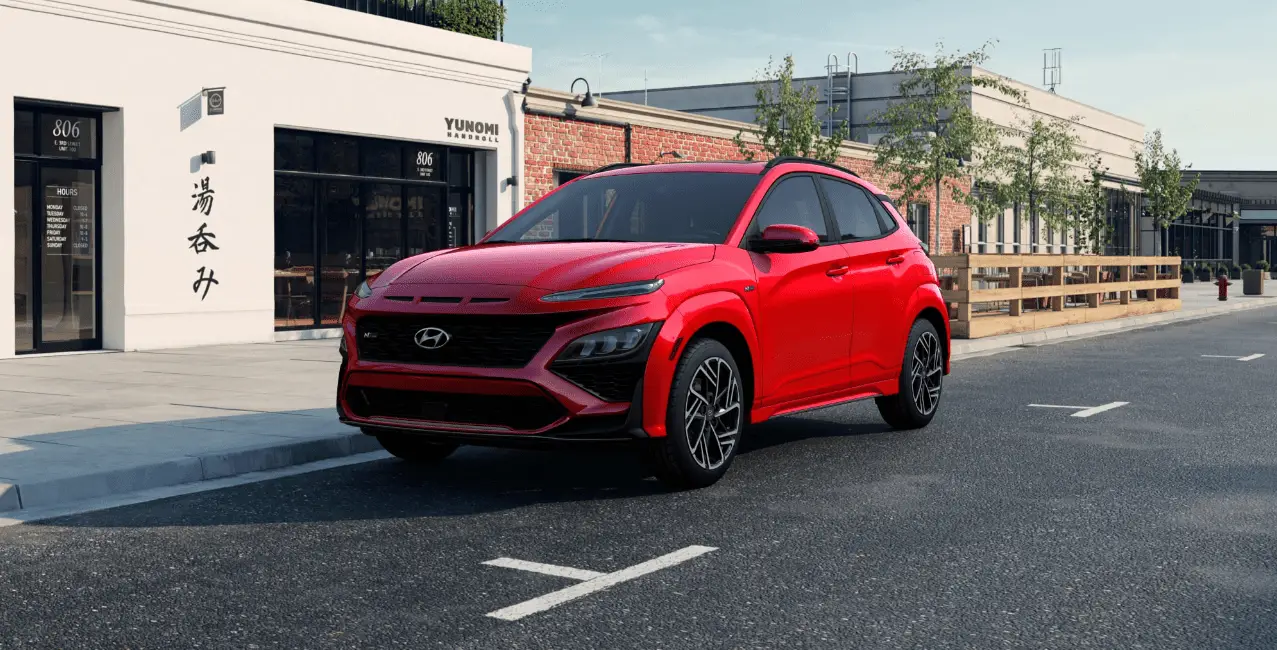Hyundai Kona 2023 Wiper Blades and Battery
The battery system and wiper blades of the Hyundai Kona 2023 are essential parts that guarantee driving stability, safety, and visibility. Wiper blades must be replaced on a regular basis to ensure optimal performance because they are in charge of providing a clear, unobstructed view in inclement weather. As the foundation of the car’s electrical system, the battery needs to be inspected and maintained on a regular basis to guarantee consistent starting and general electrical operation. Hyundai’s Battery System Guidelines and Wiper Blades offer owners vital guidance on how to protect these vital components, allowing the 2023 Hyundai Kona to reliably and confidently drive through any weather.
2023 Hyundai KONA Specs, Price, Features, Milage (Brochure)
Wiper Blades
Blade Inspection
Contamination of either the windshield or the wiper blades with foreign matter can reduce the effectiveness of the windshield wipers.
Common sources of contamination are insects, tree sap, and hot wax treatments used by some commercial car washes. If the blades are not wiping properly, clean both the window and the blades with a good cleaner or mild detergent, and rinse thoroughly with clean water.
NOTICE
To prevent damage to the wiper blades, arms or other components, do not:
- Use gasoline, kerosene, paint thinner, or other solvents on or near them.
- Attempt to move the wipers manually.
- Use non-specified wiper blades.
Information
Commercial hot waxes applied by automatic car washes have been known to make the windshield difficult to clean.
Information
Wiper blades are consumable items. Normal wear of the wipers may not be covered by your vehicle warranty.
Blade Replacement
When the wipers no longer clean adequately, the blades may be worn or cracked, and require replacement.
NOTICE
To prevent damage to the wiper arms or other components, do not attempt to move the wipers manually.
NOTICE
The use of a non-specified wiper blade could result in wiper malfunction and failure.
NOTICE
In order to prevent damage to the hood and the wiper arms, the wiper arms should only be lifted when in the top wiping position. Always return the wiper arms to the windshield before driving.
Front windshield wiper blade replacement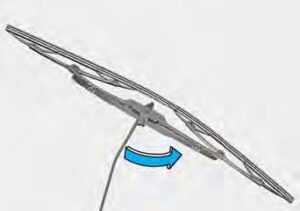
- Type A
- Put the front windshield wipers into the service position.
- Raise the wiper arm and slightly rotate the wiper blade assembly to expose the plastic locking clip.
NOTICE
Do not allow the wiper arm to fall against the windshield, since it may chip or crack the windshield.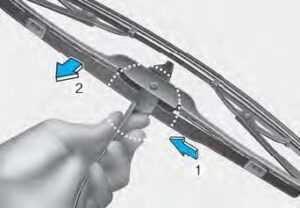
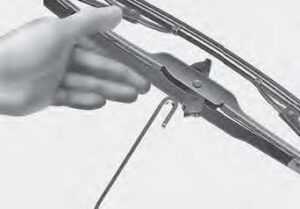
- Press the clip (1) and slide the blade assembly downward (2).
- Lift it off the arm.
- Install the blade assembly in the reverse order of removal.
- Return the wiper arm on the windshield.
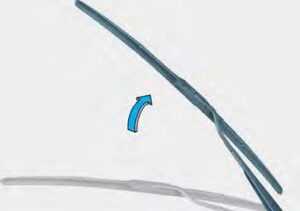
- Type B
- Raise the wiper arm.
NOTICE
Do not allow the wiper arm to fall against the windshield, since it may chip or crack the windshield.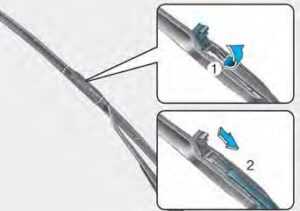
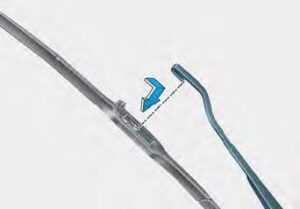
- Lift up the wiper blade clip (1). Then pull down the blade assembly (2) and remove it.
- Install the new blade assembly in the reverse order of removal.
- Return the wiper arm on the windshield.
Rear window wiper blade replacement

- Raise the wiper arm and pull out the wiper blade assembly.
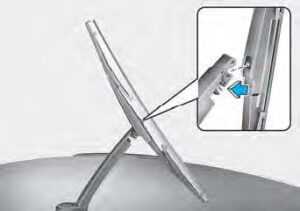
- Install the new blade assembly by inserting the center part into the slot in the wiper arm until it clicks into place.
- Make sure the blade assembly is installed firmly by trying to pull it slightly.
To prevent damage to the wiper arms or other components, have the wiper blades replaced by an authorized HYUNDAI dealer.
Battery
WARNING
To prevent SERIOUS INJURY or DEATH to you or bystanders, always follow these precautions when working near or handling the battery:
 Always read and follow instructions carefully when handling a battery.
Always read and follow instructions carefully when handling a battery. Wear eye protection designed to protect the eyes from acid splashes.
Wear eye protection designed to protect the eyes from acid splashes.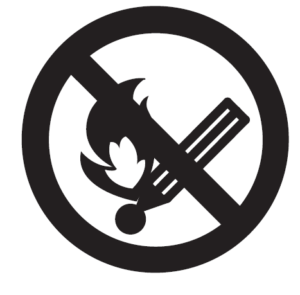 Keep all flames, sparks, or smoking materials away from the battery.
Keep all flames, sparks, or smoking materials away from the battery.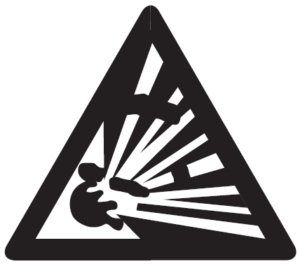 Hydrogen is always present in battery cells, is highly combustible, and may explode if ignited.
Hydrogen is always present in battery cells, is highly combustible, and may explode if ignited. Keep batteries out of reach of children.
Keep batteries out of reach of children.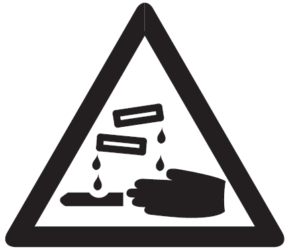 Batteries contain sulfuric acid which is highly corrosive. Do not allow acid to contact your eyes, skin or clothing.
Batteries contain sulfuric acid which is highly corrosive. Do not allow acid to contact your eyes, skin or clothing.
If acid gets into your eyes, flush your eyes with clean water for at least 15 minutes and get immediate medical attention. If acid gets on your skin, thoroughly wash the area. If you feel pain or a burning sensation, get medical attention immediately. When lifting a plastic-cased battery, excessive pressure on the case may cause battery acid to leak. Lift with a battery carrier or with your hands on opposite corners. Do not attempt to jump-start your vehicle if your battery is frozen. The electrical ignition system works with high voltage. NEVER touch these components with the engine running or when the Engine Start/Stop button is in the ON position.
WARNING
CALIFORNIA PROPOSITION 65 WARNING
Battery posts, terminals, and related accessories contain lead and lead compounds, chemicals known to the State of California to cause cancer, birth defects, and reproductive harm. Batteries also contain other chemicals known to the State of California to cause cancer. Wash hands after handling.
NOTICE
Always follow these instructions when handling your vehicle’s battery to prevent damage to your battery:
- When you do not use the vehicle for a long time in a low-temperature area, disconnect the battery and keep it indoors.
- Always charge the battery fully to prevent battery case damage in low-temperature areas.
- Prevent liquid from wetting the battery terminals. The performance of the battery may be degraded and may cause injury. Be cautious when loading liquid in the trunk.
- Do not tilt the battery.
- If you connect unauthorized electronic devices to the battery, the battery may be discharged. Never use unauthorized devices.
For the Best Battery Service
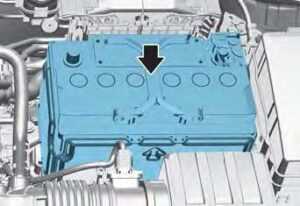
- Keep the battery securely mounted.
- Keep the battery top clean and dry.
- Keep the terminals and connections clean, tight, and coated with petroleum jelly or terminal grease.
- Rinse any spilled electrolyte from the battery immediately with a solution of water and baking soda.
- If the vehicle is not going to be used for an extended time, disconnect the battery cables.
Battery Capacity Label
 The actual battery label in the vehicle may differ from the illustration.
The actual battery label in the vehicle may differ from the illustration.
- CMF60L-BCI: The HYUNDAI model name of the battery
- 12V: The nominal voltage
- 60Ah(20HR): The nominal capacity (in Ampere hours)
- 92RC: The no mina reserve capacity (in min.)
- 550CCA: The cold-test current in amperes by SAE
- 440A: The cold-test current in amperes by EN
Battery Recharging
By battery charger
Your vehicle has a maintenance-free, calcium-based battery. Recharge your battery using a modern automatic regulated battery charger at the AGM battery setting.
WARNING
Always follow these instructions when recharging your vehicle’s battery to avoid the risk of SERIOUS INJURY or DEATH from explosions or acid burns:
- Before performing maintenance or recharging the battery, turn off all accessories and stop the engine.
- Keep all flames, sparks, or smoking materials away from the battery.
- Always work outdoors or in an area with plenty of ventilation.
- Wear eye protection when checking the battery during charging.
- The battery must be removed from the vehicle and placed in a well-ventilated area.
- The negative battery cable must be removed first and installed last when the battery is disconnected. Disconnect the battery charger in the following order:
- Turn off the battery charger main switch.
- Unhook the negative clamp from the negative battery terminal.
- Unhook the positive clamp from the positive battery terminal.
- Use batteries for replacement from an authorized HYUNDAI dealer.
NOTICE
AGM battery (if equipped)
- Absorbent Glass Matt (AGM) batteries are maintenance-free and have the AGM battery serviced by an authorized HYUNDAI dealer. For charging your AGM battery, use only fully automatic battery chargers that are specially developed for AGM batteries. When replacing the AGM battery, use parts for replacement from an authorized HYUNDAI dealer.
By jump-starting
After a jump start from a good battery, drive the vehicle for 20-30 minutes before it is shut off. The vehicle may not restart if you shut it off before the battery has a chance to adequately recharge. See “Jump Starting” in Chapter 8 for more information on jump-starting procedures.
Information
An inappropriately disposed battery can be harmful to the environment and human health. Dispose of the battery according to your local law(s) or regulation.
Reset Items
The following items may need to be reset after the battery has been discharged or the battery has been disconnected.
- Auto up/down window (see chapter 5)
- Sunroof (see chapter 5)
- Trip computer (see chapter 5)
- Climate control system (see Chapter 5)
- Clock (see chapter 5)
- Infotainment system (see infotainment system manual)
FAQ
Wiper blades typically need to be replaced every 6 months to a year, or when they show signs of wear such as streaking, chattering, or reduced effectiveness.
Owners can often replace wiper blades themselves, as it’s a straightforward process. However, some may prefer professional installation for added convenience.
The recommended wiper blade type and size can vary depending on the specific Kona model and trim. Refer to the owner’s manual or consult a Hyundai dealer for the correct specifications.
Wiper blades are typically considered wear and tear items and may not be covered by the vehicle’s warranty. It’s essential to review the warranty documentation for specifics.
The battery should be checked regularly, especially before long trips or during extreme weather conditions. It’s also crucial to monitor the battery’s health as it ages.
Yes, owners can check the battery themselves using a multimeter or by visually inspecting the battery terminals for corrosion and ensuring they are securely connected.
Common signs of a failing battery include difficulty starting the vehicle, dimming headlights, and warning lights on the dashboard.
The recommended battery type can vary based on the vehicle’s specifications. Refer to the owner’s manual or consult a Hyundai dealer for guidance on the correct battery type.
Owners can replace the vehicle’s battery themselves, but it’s essential to follow safety precautions and instructions outlined in the owner’s manual.
Regularly inspect the battery terminals for corrosion and clean them if needed. Ensure that the battery cables are securely connected.
It’s recommended to take the old battery to a designated recycling facility or automotive service center that accepts hazardous waste materials for proper disposal.
Proper wiper blade maintenance ensures clear visibility during inclement weather, while battery maintenance ensures reliable vehicle starting and electrical system performance.
Hybrid and electric versions of the 2023 Hyundai Kona may have specific maintenance considerations, and owners should refer to the vehicle’s documentation for guidance on these unique systems.
In most cases, performing routine wiper blade and battery maintenance as outlined in the owner’s manual should not void the vehicle’s warranty. However, any modifications or repairs not recommended by the manufacturer should be done by a qualified technician to avoid warranty issues.
Owners should refer to the owner’s manual for specific guidelines on preparing for wiper blade and battery maintenance. Generally, having the right tools and materials on hand and working in a well-ventilated area are essential.
Useful Link
View Full User Guide: Hyundai Kona 2023 User Guide
Download Manuals: https://owners.hyundaiusa.com/us/en/resources/manuals-warranties.html
2023 Hyundai KONA Specs, Price, Features, Milage (Brochure)

